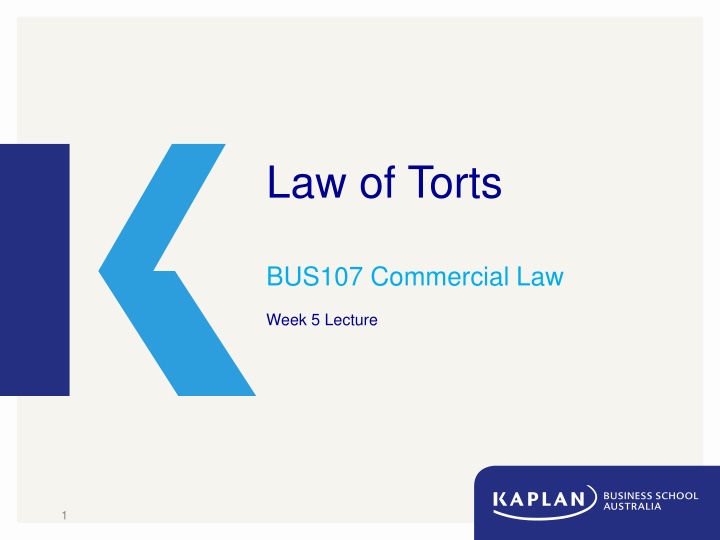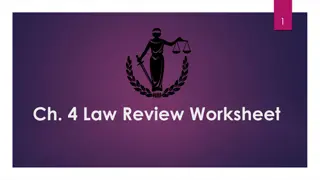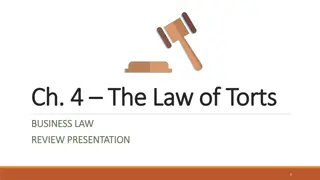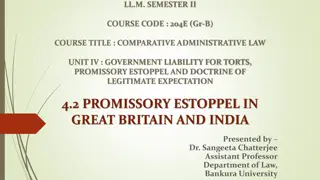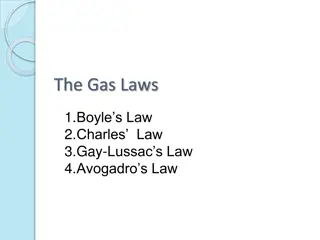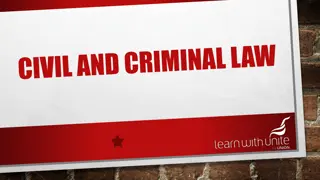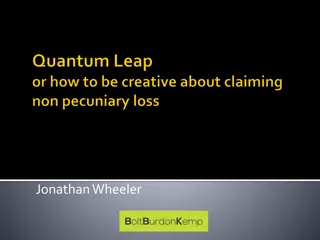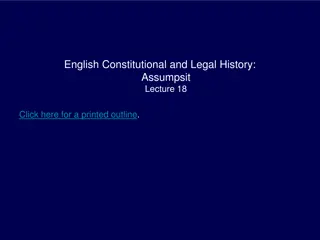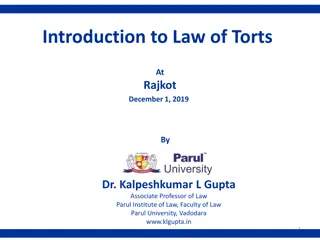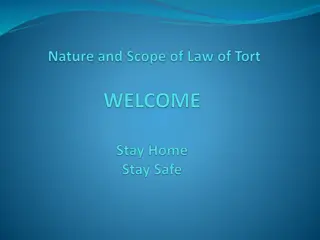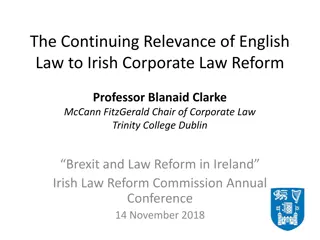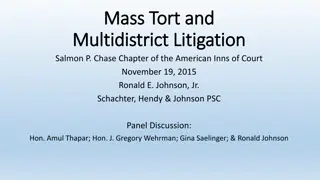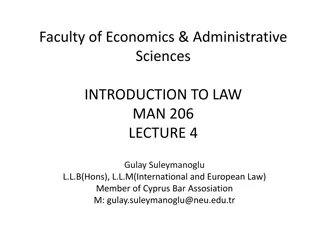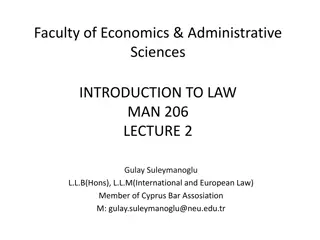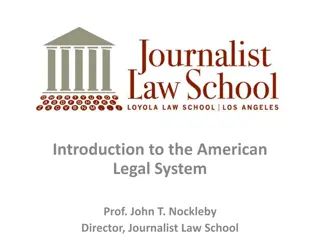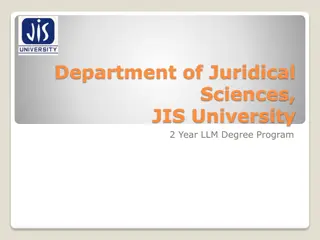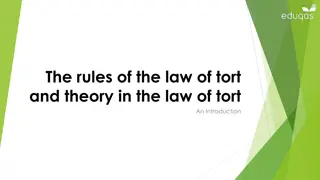Law of Torts
Learn about the duty of care in the Law of Torts, the case of Donoghue v. Stevenson, and elements of negligence in commercial law. Understand the importance of foreseeing harm to others and how it relates to legal responsibility.
Download Presentation

Please find below an Image/Link to download the presentation.
The content on the website is provided AS IS for your information and personal use only. It may not be sold, licensed, or shared on other websites without obtaining consent from the author.If you encounter any issues during the download, it is possible that the publisher has removed the file from their server.
You are allowed to download the files provided on this website for personal or commercial use, subject to the condition that they are used lawfully. All files are the property of their respective owners.
The content on the website is provided AS IS for your information and personal use only. It may not be sold, licensed, or shared on other websites without obtaining consent from the author.
E N D
Presentation Transcript
Law of Torts BUS107 Commercial Law Week 5 Lecture 1
Small Group Discussion What does Scottish industrialist Andrew Carnegie mean when he says: Do your duty and a little more and the future will take care of itself 2
Small Group Challenge On 7 December 2012, Jacintha Saldanha, a nurse from India working in a London hospital was found dead in her nurse s quarters. She had hanged herself. Three days prior, two Australian radio show hosts made a prank call to Jacintha impersonating the Queen and Prince Charles. They asked to speak to the Princess of Cambridge who was a patient at the hospital. Jacintha transferred the call to another nurse who spoke to the pranksters for around two minutes. In groups, describe the nature of the relationship between Jacintha and the radio hosts. 3
Negligence - Elements 1. Duty of Care 2. Breach of Standard of Care 3. Causation & Remoteness 4. Contributory Negligence 5. Voluntary Assumption of Risk 6. Statutory Limits 4
What is a duty of care? Our words and actions can have deep and lasting impact on other people Others can suffer injury because of your carelessness An important relationship arises between you and anyone else who could be injured by your actions In circumstances where you should be able to predict that someone else could be injured by your actions you owe that person a duty to refrain from those actions 5
Whats in the bottle? Ginger Beer 6
Who is your neighbour? When you are about to do something or not do something any person that may be affected that you should consider their wellbeing before you act is your neighbour : see Donoghue v Stevenson 7
Donoghue v Stevenson [1932] AC 562 The rule that you are to love your neighbour becomes in law, you must not injure your neighbour; and the lawyer's question, Who is my neighbour? receives a restricted reply. You must take reasonable care to avoid acts or omissions which you can reasonably foresee would be likely to injure your neighbour. Who, then, in law, is my neighbour? The answer seems to be persons who are so closely and directly affected by my act that I ought reasonably to have them in contemplation as being so affected when I am directing my mind to the acts or omissions which are called in question 8
Recognised duties of care Authorities government, police Builders to clients, homeowners Drivers to passengers, road users Manufacturers to consumers Advisers to those relying on advice Occupiers to visitors, tenants 9
But I didnt realise lighting firecrackers in the schoolyard would burn the children. Honestly! Well you should have Why? Because a reasonable person would have A what? A reasonable person is a typical community member with the common sense of that community 10
Small Group Discussion Do you agree with German statesman Johann Wolfgang von Goethe when he says: Precaution is better than cure 11
Small Group Challenge On 24 March 2015, Germanwings co-pilot Andreas Lubitz intentionally crashed a plane in the French Alps killing all 144 passengers and 6 crew members. According to French and German prosecutors, Lubitz locked the pilot out of the cockpit after he left to use the toilet. In response to the incident, aviation authorities in Australia implemented new regulations that require at least two authorised personnel in the cockpit at all times. In groups, consider whether or not the new regulations will be an effective precaution to stop a similar incident from happening again. 12
Calculating Risk Every action we take carries some degree of potential risk to ourselves and to others Risk can be categorised according to seriousness: insignificant, low, medium, high, extreme Risk can be determined by assessing the likelihood of occurrence and the seriousness of the consequences 13
Standard of Care We are expected to take reasonable precautions to prevent our actions from causing injury to other people Your actions will fail to meet the standard of care and breach your duty of care to your neighbour if the risk of injury was reasonably forseeable, not insignificant, and you failed to take reasonable precautions: see Civil Liability Acts 14
Small Group Discussion What does American poet Ralph Waldo Emerson mean when he says: Shallow men believe in luck. Strong men believe in cause and effect 15
Small Group Challenge On a sunny morning in 1943 a black South African woman and her young son were out walking in Sophiatown, the slum they lived in near Johannesburg. A white priest named Trevor Huddleston tipped his hat towards the woman as he passed, a small but extremely unconventional gesture of courtesy between two races separated by apartheid. But the boy never forgot it. To him it suggested that not all white people were oppressive. He grew up to become an instrumental activist in the struggle against apartheid and headed the Truth and Reconciliation Commission. He won the Nobel Peace Prize in 1984 for his efforts in resolving and ending apartheid. In groups, discuss whether Trevor Huddleston s gesture caused apartheid to end in South Africa. 16
Causation To be recoverable from the defendant the losses incurred must actually be caused by the negligent act We can ask the question, If the negligent act had never happened would the plaintiff have suffered a loss? This is called the but for test: see Cork v Kirby MacLean 17
Cork v Kirby Maclean Ltd [1952] 1 All ER 1064 C was working on a narrow platform 23 feet above the floor of a factory. There were no guard rails. He had an epileptic fit and fell to his death. He knew he was epileptic, but his employers did not. His employers were clearly in breach of their duty of care to him, as guard rails should have been fitted. However, they argued that they did not cause his death: they said that the epilepsy killed him. Rule If the damage would not have happened but for D s breach of duty (the lack of guard rails), then D s breach is the cause of that damage. Conversely, if the damage would have occurred in any event, then the breach of duty cannot be said to be the cause of C s damage. 18
Cork v Kirby Maclean Ltd [1952] 1 All ER 1064 The court held: If the guard rails had been in place then C would probably have survived he would still have had a fit, but would not have fallen to his death. Therefore, C (or rather his widow) proved that his employer s breach was the factual cause of his death. There were no intervening events which could be regarded as having broken the chain of causation, so legal causation was also established. 19
Remoteness To be recoverable the losses incurred must actually be caused by the negligent act and not be too remote This means that the damage must not only be a direct consequence of the negligent act, but must have also been reasonably forseeable: see Overseas Tankship (UK) Ltd v The Miller Steamship Co Pty Ltd Would it be reasonably forseeable to a ship s engineer that furnace oil spilled into the harbour might catch on fire? 20
Overseas Tankship (UK) Ltd v The Miller Steamship Co Pty Ltd The defendant s crew carelessly allowed a large quantity of oil spill into Sydney Harbour from the defendant s ship. The oil settled around a wharf where the plaintiff s ships were moored. The oil caught fire when molten metal fell onto some cotton waste floating on the oil. The fire destroyed the plaintiffs ships. The court held that: The ships engineer of the defendant s ship ought to have known that furnace oil on water had caught fire before. Once fire was reasonably foreseeable, the possibility of damage to ships in the vicinity was also reasonably foreseeable. The defendant was held liable. 21
Small Group Discussion Do you agree with Austrian psychologist Alfred Adler when he says: The chief danger in life is that you may take too many precautions 22
Small Group Challenge The Australian Association of Adventurers (AAA) has a serious problem The Association is shocked by a recent case from New Zealand where an injured customer successfully sued an adventure tour business in negligence for the damage done to her spine whilst performing a bungee jump. The President of the AAA is worried that adventure services businesses in Australia that offer high risk activities such as skydiving, hang gliding, and jet boat cruises may also be exposed to negligence claims if their customers sustain injuries. The President of the AAA seeks your advice. In groups, prepare at least two strategies that AAA can recommend to its members to protect them from negligence claims. 23
Voluntary Assumption of Risk We cannot blame or sue others for injuries sustained where we have understood and accepted the risks involved Voluntary assumption of risk is a complete defence to an action in negligence 24
Contributory Negligence Where a person is also careless regarding their own safety the court will apportion the negligence between the plaintiff and the defendant and award damages accordingly: see Imbree v McNeilly If you cross the road carelessly and get hit by a car being driven carelessly then your own negligence will have contributed to your damages 25
Imbree v McNeilly The plaintiff was injured in a motor accident The plaintiff was supervising the defendant driver. The defendant driver was 16 years of age and had just obtained a learner s permit. The plaintiff knew that he was inexperienced. The defendant attempted to steer the vehicle to avoid tyre debris on the road. Despite the plaintiff yelling at him to brake, the defendant turned sharply to the left and accelerated, causing the vehicle to roll. The plaintiff suffered spinal injuries in the accident and was rendered a tetraplegic. 26
Imbree v McNeilly The court held An inexperienced driver owes the same standard of care as any other person driving a motor vehicle to take reasonable care to avoid injury to others. The obligation to drive to the standard of a reasonable driver is not to be qualified by reference to the holding of a licence or by reference to the driver s level of experience. Inexperience remains relevant to the assessment of contributory negligence. The plaintiff was found to be contributorily negligent due to his failure, having observed the debris on the road, to instruct the defendant. The plaintiff s responsibility for the accident was not insignificant and was assessed at 30%. 27
Negligent Misstatement People providing information such as professional advisers and information officers owe a duty of care to those they advise to avoid making careless statements that cause harm 28
Civil Liability Acts Claims for personal injuries under the common law of negligence have now been limited by the Civil Liability Acts This legislation promotes personal responsibility The Civil Liability Acts place a statutory cap on general damages for claims for personal injury and death around $400,000-$500,000 29
